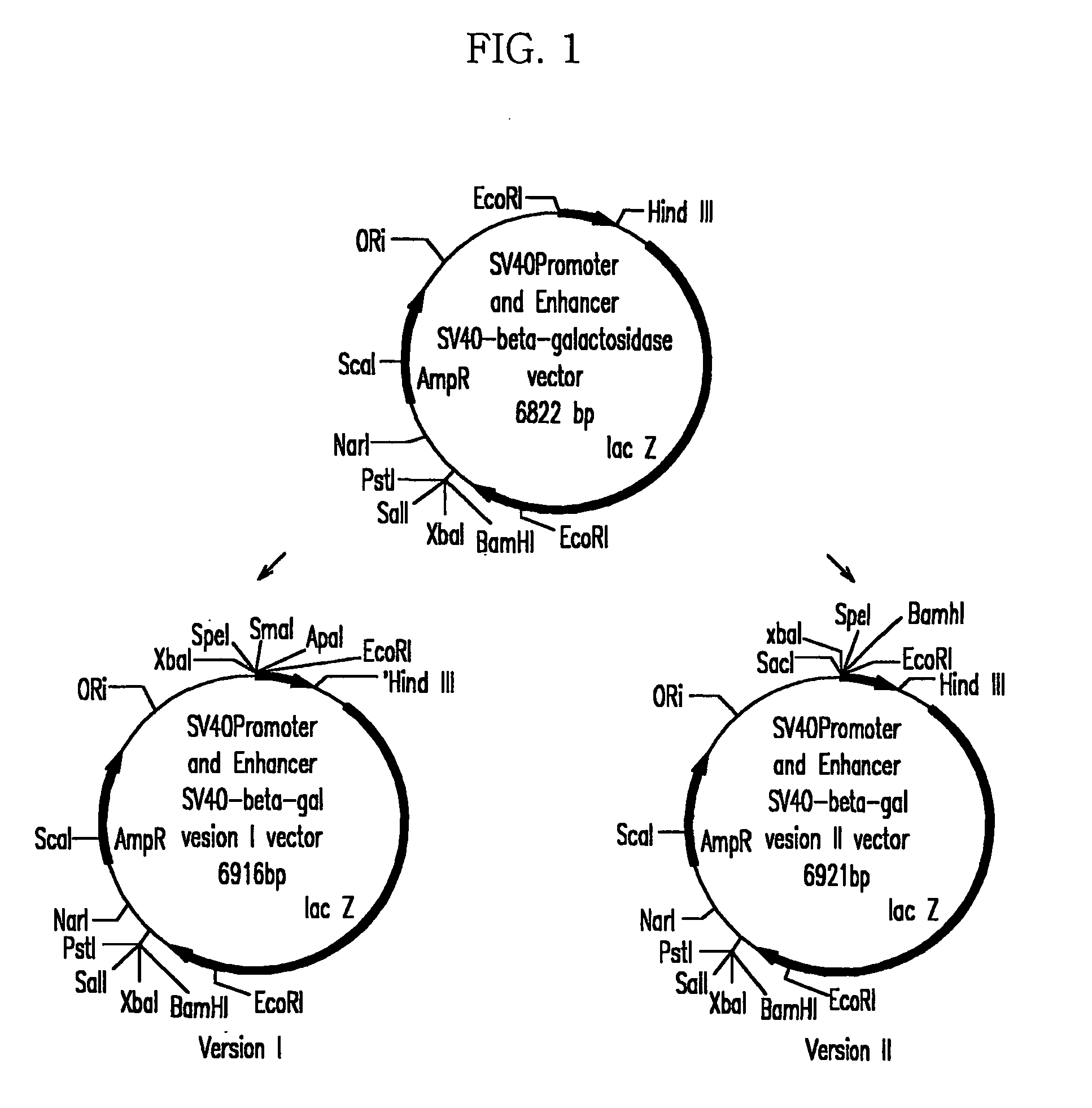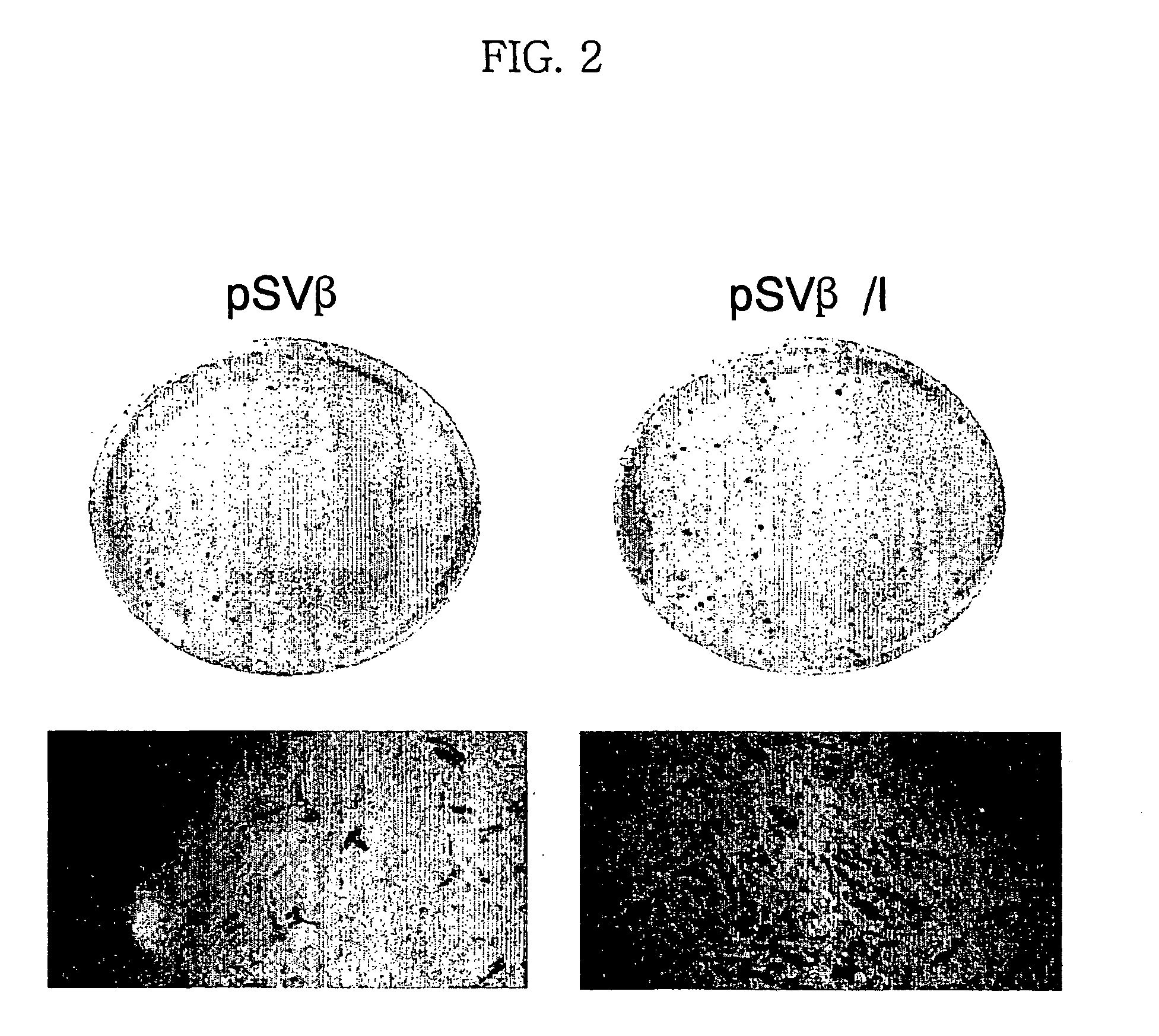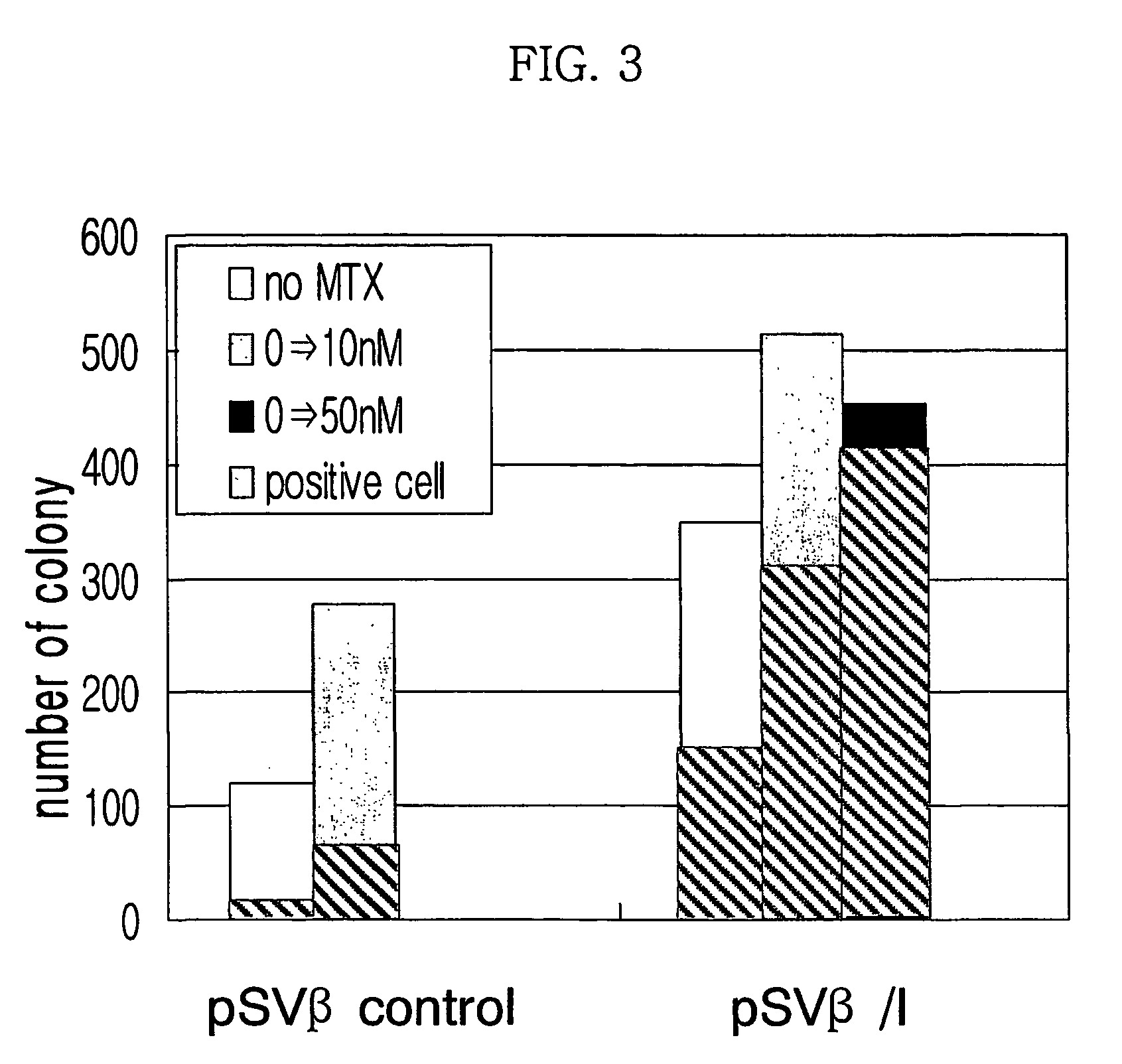Expression vector for animal cell containing nuclear matrix attachment region of interferon beta
a technology of interferon beta and expression vector, which is applied in the field of mammalian expression vector including the nuclear matrix attachment region of interferon gene, can solve the problems of inability to easily industrialize, low expression efficiency of microorganisms, and high unit cost of production, and achieve the effect of increasing the expression efficiency of foreign proteins
- Summary
- Abstract
- Description
- Claims
- Application Information
AI Technical Summary
Benefits of technology
Problems solved by technology
Method used
Image
Examples
example 1
Cloning of MAR or SAR Factor
[0051]Genomic DNA was isolated from human G-2 cells using a Wizard Genomic DNA purification kit (Promega, U.S.A.). 10 μg of DNA were cut with ClaI, SmaI, XbaI, and XhoI restriction enzymes to use in the PCR process. DNA to be used in PCR was separated and purified from a CHO chicken cell line and a chicken embryo by a similar method.
[0052]200 ng of the isolated genomic nucleic acid was used as a template, and 25 pmole of each primer, 0.5 mM of dNTP, and ExTaq polymerase (Takara Shuzo Co., Japan) were added to carry out PCR. The base sequence of primer used for each MAR / SAR factor and size of DNA fragment obtained by PCR are as shown in Table 4. PCR was carried out using a GeneAmp PCR system 9600 (Perkin-Elmer Corp. U.S.A.), and PCR conditions are as shown in Table 5.
[0053]
TABLE 4SEQ IDMAR / SAR factorPrimerNO:SizeChicken lysozyme5′-GGA TCC ATA ATA TAA CTG TA-3′41668 bp5′MAR5′-AAG CTT AAA AGA TTG AAG CA-3′5Chicken phi α5′-AAG CTT TTA ACC AAC AAA AA-3′6 619 b...
example 2
Construction of pSV-β-gal / ver I and pSV-β-gal / ver II Vectors
[0057]In order to effectively clone multiple MAR / SAR factors subcloned in the pT7blue (R) or pCR 2.1 vector at upstream of a SV40 promoter of a pSV-β-gal (hereinafter referred to as ‘pSVβ’) vector, modified pSV-β-gal / ver I and PSV-β-gal / ver II vectors were constructed (FIG. 1).
[0058](1) Construction of pSV-β-gal / ver I
[0059]PCR was carried out with pSVβ as a template with primers of SEQ ID NO: 16 and SEQ ID NO: 17 to obtain a fragment including the SV40 promoter. The fragment was cut with SpeI and HindIII enzymes, and a 443 bp of DNA fragment including SV40 was purified with a Geneclean III kit (Bio 101, U.S.A). It was subcloned in a opened pBluescript SK (+) vector (Stratagene, U.S.A.) with SpeI and HindIII enzymes to construct pBS / SV40 I.
[0060]The pBS / SV40 I was digested with ScaI and HindIII enzymes to separate a 1240 bp DNA fragment, and it was subcloned in pSVβ treated with the same enzymes to complete a pSV-β-gal / ver v...
example 3
Construction of a Vector Including MAR Factor and β-gal Gene
[0063]MAR factors were separated from pT7blue(R) / HPRT MAR, bT7blue(R) / DHFR MAR, pT7blue(R) / lyso MAR, pCR 2.1 / phi-a MAR, pCR 2.1 / CSP-B MAR, and pCR 2.1 / interferon β MAR, and cloned in pSVβ / I or pSVβ / II.
[0064]In a pSVβ / I, phi-a MAR and HPRT MAR (human HPRT intron MAR) were subcloned using SpeI / SmaI, and interferon β MAR and lyso MAR were subcloned using ApaI / SpeI. Constructed vectors were pSV-β-gal / phi-a MAR, pSV-β-gal / HPRT MAR, pSV-β-gal / interferon β MAR (hereinafter referred to as ‘pSVβ / I’), and pSV-β-gal / lyso MAR.
[0065]Additionally, DHFR MAR and CSP-B MAR were subcloned in pSV-β-gal / ver II at BamHI / Xba I restriction site. Constructed vectors were pSV-β-gal / DHFR MAR and pSV-β-gal / CSP-B MAR respectively.
PUM
| Property | Measurement | Unit |
|---|---|---|
| pH | aaaaa | aaaaa |
| pH | aaaaa | aaaaa |
| structure | aaaaa | aaaaa |
Abstract
Description
Claims
Application Information
 Login to View More
Login to View More - R&D
- Intellectual Property
- Life Sciences
- Materials
- Tech Scout
- Unparalleled Data Quality
- Higher Quality Content
- 60% Fewer Hallucinations
Browse by: Latest US Patents, China's latest patents, Technical Efficacy Thesaurus, Application Domain, Technology Topic, Popular Technical Reports.
© 2025 PatSnap. All rights reserved.Legal|Privacy policy|Modern Slavery Act Transparency Statement|Sitemap|About US| Contact US: help@patsnap.com



